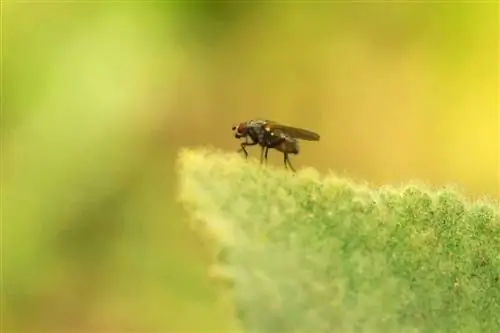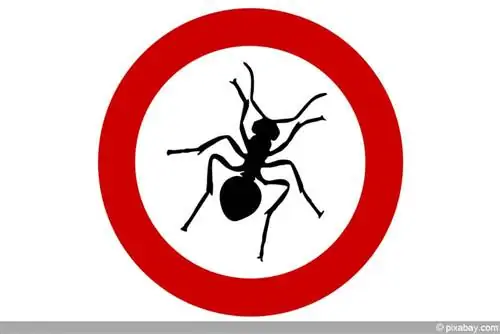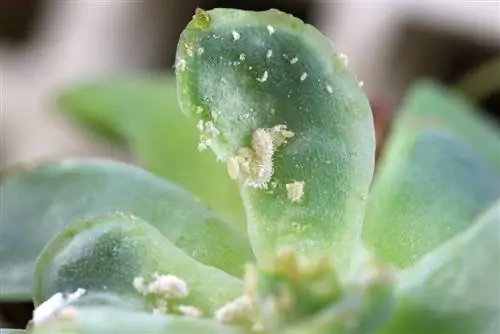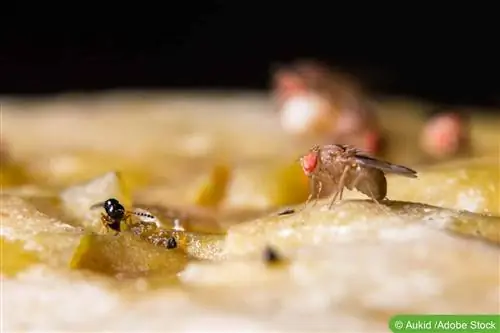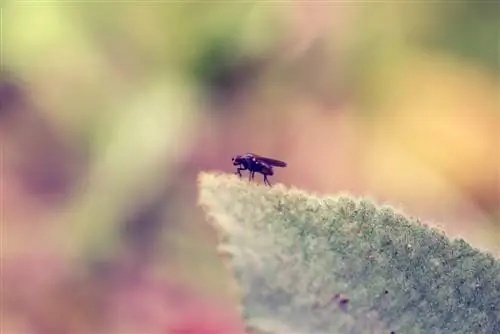- Author admin [email protected].
- Public 2023-12-17 03:39.
- Last modified 2025-01-24 12:45.
If you want to combat houseflies sustainably, you should take a look at their living conditions. The profile of the insects provides information about what they like and hate. From this, countermeasures can be derived.
Bait with sugar water
Flies like the smell of sweet foods. Empty wine bottles are an ideal basis for building a simple fly trap. The neck of the bottle forms a kind of funnel through which the smell flows out in a concentrated form and attracts insects. Once they have crawled into the container, they can no longer get out through the narrow opening and die. With the right mixture, the trap achieves the best possible results:
- fill two tablespoons of sugar into the bottle using a funnel
- Fill the wine bottle halfway with lukewarm water
- Swirl the container until the sweetener has completely dissolved
- add a few splashes of dish soap to reduce surface tension
Make your own glue traps
Glue traps are popular ways to get rid of annoying house flies. The sticky paper strips are made from different substances including natural resin, honey and rosin. An attractant is used to make the insects aware of the trap. They are suitable as a permanent method of keeping fly infestation under control. Glue traps are not enough to combat an acute fly plague. How to make your own glue trap:
- Cut a piece of paper into several elongated strips
- Punch a hole in the top side
- Put a string through the opening and secure it with a knot
- Dip paper strips into a viscous mixture of honey, sugar and water until they are soaked
- Attach the honey strips to a stick with the string and hang them up to dry
- distribute dried traps in living rooms
Tip:
You can also use resin from conifers instead of honey. At the same time, this exudes a pleasant forest scent in the apartment.
Attracting with light
Musca domestica is attracted to light sources. This explains why flies often come into brightly lit apartments through open windows in the evening. You can take advantage of this preference with a little skill and the right utensils. Simply combine an adhesive trap with a light source to which the insects are attracted:
- cleaning old glass or empty cans
- smear the upper edge of the vessel with resin or honey
- alternatively, attach double-sided adhesive tape on the inside in the upper area
- Put in a tea light, LED or flashlight
Deterring with scents
Intensely smelling spices and essential oils have a deterrent effect on the housefly, so that it runs away or doesn't come into the apartment at all. The duration of effectiveness of essential oils is limited as they are quickly volatile. It is therefore important to repeat the measures daily:
- Dissolve chili powder in warm water and spray onto popular seats with an atomizer bottle
- Let eucalyptus or laurel oil evaporate in an aroma lamp
- fill half a lemon with crushed cloves and place on window sills
Make a meat trap
Fish and meat are typical foods that attract house flies. You can use the leftovers from your last meal to make yourself an effective fly trap. Since the smell increases over time and can become a nuisance, you should replace this trap after a week at the latest.
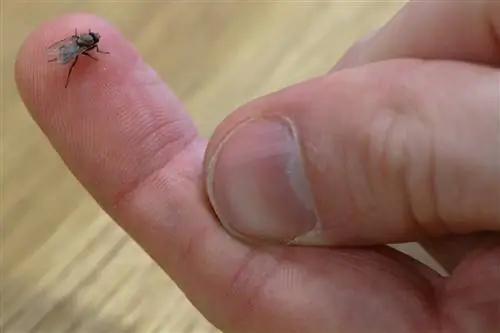
How to make your own trap:
- Fill the vase halfway with water
- Add maple syrup, honey or sugar
- Cut raw meat into small pieces and put in the bottle
- Add a few drops of dishwashing liquid
- Cover the opening with cling film and make several holes
- Fix the film with rubber
Tip:
You can also use overripe fruit as an alternative to meat. A few splashes of vinegar further increase the attraction.
Keep your apartment cool
The housefly prefers a warm and windless environment in which the food supply is varied. Therefore, homes that are easily accessible to the insects through open windows and doors are an ideal place to find egg-laying sites and food sources. The warmer it is, the better the next generations of flies can develop. For this reason, you should pay particular attention to the room temperature for effective control:
- Keep the temperature of the apartment at 16 degrees
- keep shutters or blinds closed during the day to block sunlight
- ventilate several times in the morning and evening at smaller intervals
Properly store organic waste
Houseflies love the smell of biodegradable waste that collects in the trash can. If this is open, the annoying insects have easy access to the food source. You should therefore temporarily store the organic waste in lockable buckets. Measures such as correct placement and care are of great importance for trash cans:
- Do not place the container in the sun
- A cool place under the sink is better
- Dispose of waste daily in the compost or in the garbage can
- Then clean the bucket with hot water and a dash of vinegar
Tip:
A large box with a lock closure and a rubber seal in the lid is even better. With this variant you not only prevent infestation by house flies, but also make it difficult for fruit flies to survive.
Growing aromatic plants

Some useful plants and culinary herbs not only enrich the menu, but also keep flies out of the house and apartment thanks to their essential oils. The aromas spread into the air when the leaves are touched. Wind further increases this effect. The following plants like the conditions on the windowsill:
- Tomato plants (Solanum lycopersicum) benefit from rain-protected conditions outside the window
- Basil (Ocimum basilicum) feels comfortable in bright places
- Catnip (Nepeta cataria) thrives in sunny and dry conditions
Setting up carnivorous plants
Carnivorous plants have specialized in catching protein-rich insects. They develop various catching mechanisms, exude attractive aromas and attract their prey with intense colors. Because of their comparatively large traps, these carnivorous species are ideal for getting one or two house flies out of the way:
- Dionaea muscipula: easy-careVenus fly trap for the windowsill
- Nepenthes alata x ventricosa:Pitcher plant,which is suitable for hanging baskets
- Sarracenia purpurea:Pitch plant,that feels comfortable in a pot outside the greenhouse
Attach fly screen
An effective method to prevent houseflies from getting into your own four walls is to install fly screens. Prefabricated fly frames are sturdy and can be opened and closed, while nets with self-adhesive Velcro are sufficient for small windows.

